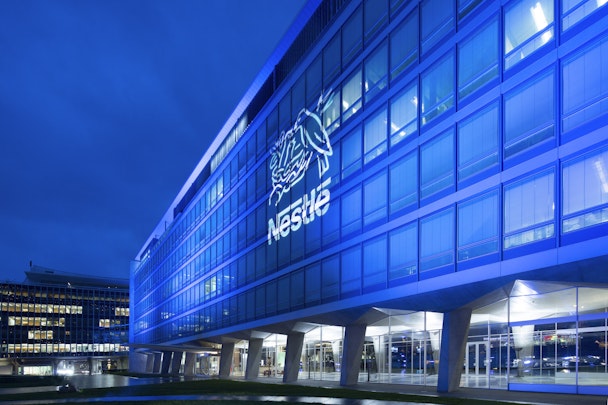How Nestlé is using AI to set creative rules for its 15,000 marketers
The food and beverage giant’s chief marketing officer has led an overhaul of its creative process after investing in artificial intelligence tool.

Nestlé headquarters in Vevey, Switzerland / Nestlé
In 2021, Nestlé embarked on an ambitious plan to put all its creative through an AI platform that would rank ads based on their suitability to different online platforms and pull out the key elements that are required for maximum ROI.
That process created a set of ’rules’ for successful campaigns and early tests generated transformational results, finding that ads that meet the new creative requirements generate a significantly higher return on ad spend.
Now, Nestlé’s 15,000 marketers – who work across 2,000 brands in 200 territories – as well as its agency partners are required to run all creative assets through the system to check they meet the new requirements before they can run.
Advertisement
Nestlé’s online marketing challenge
Leading the initiative is Aude Gandon, Nestlé’s senior vice-president and global chief marketing and digital officer. The decision to review its creative approach stemmed from her lofty ambitions for online marketing to account for 70% of Nestlé’s media mix. She wants it to pivot from being a TV-first advertiser to a digital-first one. This radical investment in digital media has meant Nestlé must ensure all of its online ads are as effective as possible.
“It’s not like the world of TV, where you have one creative and you can cut it down and put it on YouTube or Facebook,” she explains.
“We needed to help marketers understand that there are new rules of creative engagement on different platforms. Nestlé’s marketing operation is highly complex, with thousands of marketers – and even more agency partners – spanning hundreds of countries. The shift and evolution of media at the same time as the complexity of Nestlé meant we needed a way to give guidance and a framework.”
The marketer was also acutely aware of the “wasted time” when creatives are stressing over minute nuances between online platforms. Pre-established rules for creating online content, she says, would give its marketers and agencies “the space to talk about the creative again”.
Advertisement
Gandon sought the help of CreativeX, a company that builds creative data platforms for brands, and plugged thousands of historical campaigns into its AI, analyzing the ads to find the elements that drove better results. Once analyzed, the company created a new metric, the Creative Quality Score, which ranks an asset based on its suitability to different platforms such as Meta or YouTube.
CreativeX’s chief executive and founder Anastasia Leng explains that Nestlé wanted to know whether an ad meets the baseline to be successful in its environment. “Creative Quality Score doesn’t always mean it being a great ad – it is necessary, but not sufficient, for great creative work.” An ad that doesn’t fit its environment, she says, is “like a car without wheels – it can’t get to its destination”.
An example of the types of learning include adding sound for the right platforms: for YouTube, sound is an amplifier, whereas on Meta 90% of content is watched without sound.
Once the review had been completed and the Creative Quality Score adopted, Nestlé integrated the tech into the platforms where it was running ads.
Today, Nestlé’s marketers and agency partners must upload new assets into CreativeX and check the score to see if it meets the requirements before it can run. And when a new rule is created, every marketer working on Nestlé campaigns will have to implement it from the minute it’s programmed into CreativeX.
“Before, someone would have had to do a roadshow and convince every creative agency they needed to move the logo and prove why it’s effective,” explains Leng. “Now, any new asset it creates can automatically be checked and we can spit out a report that says what was done right and what was done wrong in line with Nestlé’s guidelines.”
Suggested newsletters for you
The real results of Nestlé and CreativeX’s AI review
Historically, online creative data has been measured against engagement metrics such as click-through rates, but with Meta’s help, Nestlé and CreativeX managed to correlate campaign data to offline sales.
The creative data was pulled into a Marketing Mix Modelling (MMM) study by Meta to generate a return on ad spend (ROAS) figures – according to Leng, an industry first. Ads that had a creative quality score of above 66% had a 66% higher ROAS.
FMGC brands are going through a tough time right now as inflation and recession bite. Gandon assures us that Nestlé won’t be cutting ad spend through this period, saying that while it has “gone up and down in ad spend in the last few years,” it is “looking at increasing ad spend and supporting brands”.
The project with CreativeX is a way of increasing investment, she says, adding: “We are doing it smartly so that, when we do do it, we know it will contribute to our growth.”
Cutting down ‘wasted time’
Prior to the CreativeX integration, Gandon says her teams were “wasting time having endless discussions” about whether the logo placement in an ad had made it underperform when she would rather be discussing the idea or the execution. The initiative essentially gives creatives tight rules to adhere to – rules that were generated by AI.
AI’s role in creativity is under intense scrutiny since the rise of platforms like ChatGPT. “You can imagine when you tell your entire organization – especially creatives – that we are working with this new tool and AI is going to manage it. There would be chaos, people would think it’s going to be cookie cutter but it’s not like that at all,” says Gandon.
Leng, meanwhile, adds: “Some of these rules sound unsexy, but these are basic things that create the canvas on which an idea can be successful.”

